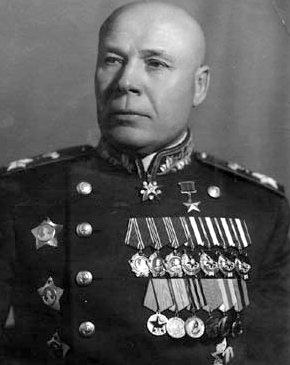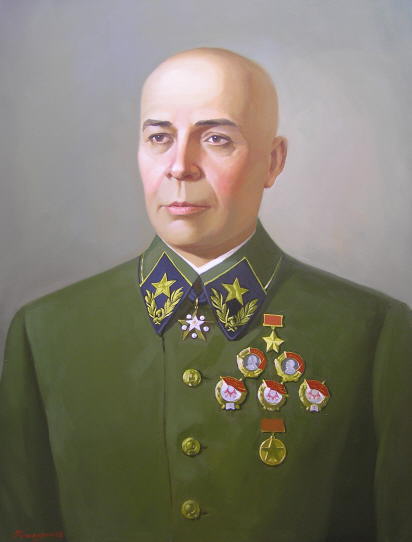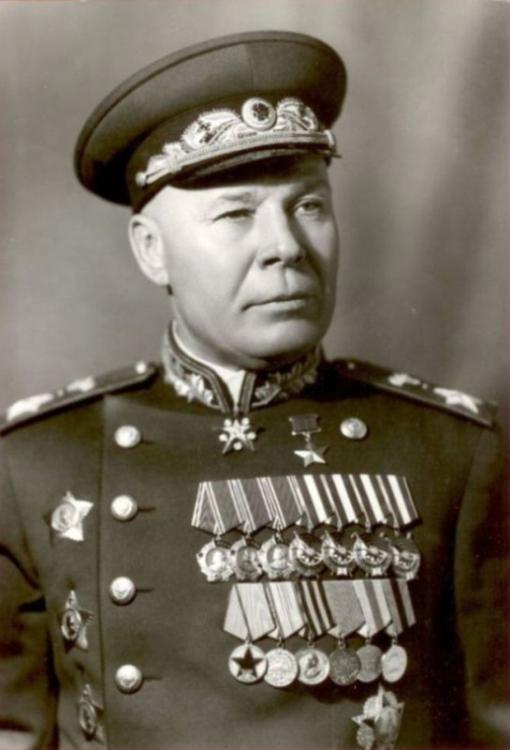<Back to Index>
- Entrepreneur Enzo Anselmo Ferrari, 1898
- Writer Alexander Lange Kielland, 1849
- People's Commissar of Defense Marshal Semyon Konstantinovich Timoshenko, 1895
PAGE SPONSOR



Semyon Konstantinovich Timoshenko (Russian: Семён Константи́нович Тимоше́нко; Ukrainian: Семе́н Костянти́нович Тимоше́нко) (February 18 [O.S. February 6] 1895 – March 31, 1970) was a Soviet military commander and senior professional officer of the Red Army at the beginning of the German invasion of the Soviet Union in 1941.
Timoshenko was born into a peasant family at Furmanivka, in Southern Bessarabia, now a part of Odessa Oblast, Ukraine. In 1915, he was drafted into the army of the Russian Empire and served as a cavalryman on the western front. On the outbreak of the Russian Revolution in 1917, he sided with the revolutionaries, joining the Red Army in 1918 and the Bolshevik Party in 1919.
During the Russian Civil War, Timoshenko fought on various fronts. His most important encounter occurred at Tsaritsyn (later renamed Stalingrad, and now Volgograd), where he met and befriended Joseph Stalin. This would ensure his rapid advancement after Stalin gained control of the Communist Party by the end of the 1920s. In 1920 - 1921, Timoshenko served under Semyon Budyonny in the 1st Cavalry Army; he and Budyonny would become the core of the "Cavalry Army clique" which, under Stalin's patronage, would dominate the Red Army for many years.
By
the end of the Civil and Polish - Soviet Wars, Timoshenko had
become commander of the Red Army cavalry forces.
Thereafter, under Stalin, he became Red Army commander
in Belarus (1933);
in Kiev (1935);
in the northern Caucasus and then Kharkov (1937);
and Kiev again (1938). In 1939, he was given command
of the entire western border region and led the Ukrainian Front during
the Soviet occupation of
eastern Poland. He also became a member of the
Communist Party's Central Committee.
As a loyal friend, Timoshenko survived Stalin's Great Purge, to be
left as the Red Army's senior professional soldier.
In January 1940, Timoshenko took charge of the Soviet armies fighting Finland in the Soviet - Finnish War. This had begun the previous November, under the disastrous command of Kliment Voroshilov. Under Timoshenko's leadership, the Soviets succeeded in breaking through the Finnish Mannerheim Line on the Karelian Isthmus, prompting Finland to sue for peace in March. His reputation increased, Timoshenko was made the People's Commissar for Defense and a Marshal of the Soviet Union in May. John Erickson writes: "Although by no means a military intellectual, Timoshenko had at least passed through the higher command courses of the Red Army and was a fully trained 'commander - commissar'. During the critical period of the military purge, Stalin had used Timoshenko as a military district commander who could hold key appointments while their incumbents were liquidated or exiled."
Timoshenko
was
a competent but traditionalist military commander who
nonetheless
saw the urgent need to modernize the Red Army if, as
expected, it was
to fight a war against Nazi Germany.
Overcoming the opposition of other more conservative
leaders, he undertook the mechanization of the
Red Army and the production of more tanks. He also
reintroduced much of the traditional harsh discipline
of the Tsarist Russian Army.
When the Germans invaded the Soviet Union in June 1941, Stalin took over the post of Defense Commissar and sent Timoshenko to the Central Front to conduct a fighting retreat from the border to Smolensk. In September, he was transferred to Ukraine, where the Red Army had suffered 1.5 million casualties while encircled at Uman and Kiev.
In May 1942, Timoshenko, with 640,000 men, launched a counter-offensive (the Second Battle of Kharkov) which was the first Soviet attempt to gain the initiative in the war. After initial Soviet successes, the Germans struck back at Timoshenko's exposed southern flank, halting the offensive and turning the battle into a Soviet defeat.
General Georgy Zhukov's success in defending Moscow during December 1941 had persuaded Stalin that he was a better commander than Timoshenko. Stalin removed Timoshenko from front line command, giving him roles as overall commander of the Stalingrad (June 1942), then North - Western (October 1942), Leningrad (June 1943), Caucasus (June 1944) and Baltic (August 1944) fronts.
In 1944, his daughter Ekaterina married Stalin's son Vasily.
After the war, Timoshenko was reappointed Soviet Army commander in Belarus (March 1946), then of the southern Urals (June 1946); and then Belarus once again (March 1949). In 1960, he was appointed Inspector - General of the Defense Ministry, a largely honorary post. From 1961 he chaired the State Committee for War Veterans. He died in Moscow in 1970.